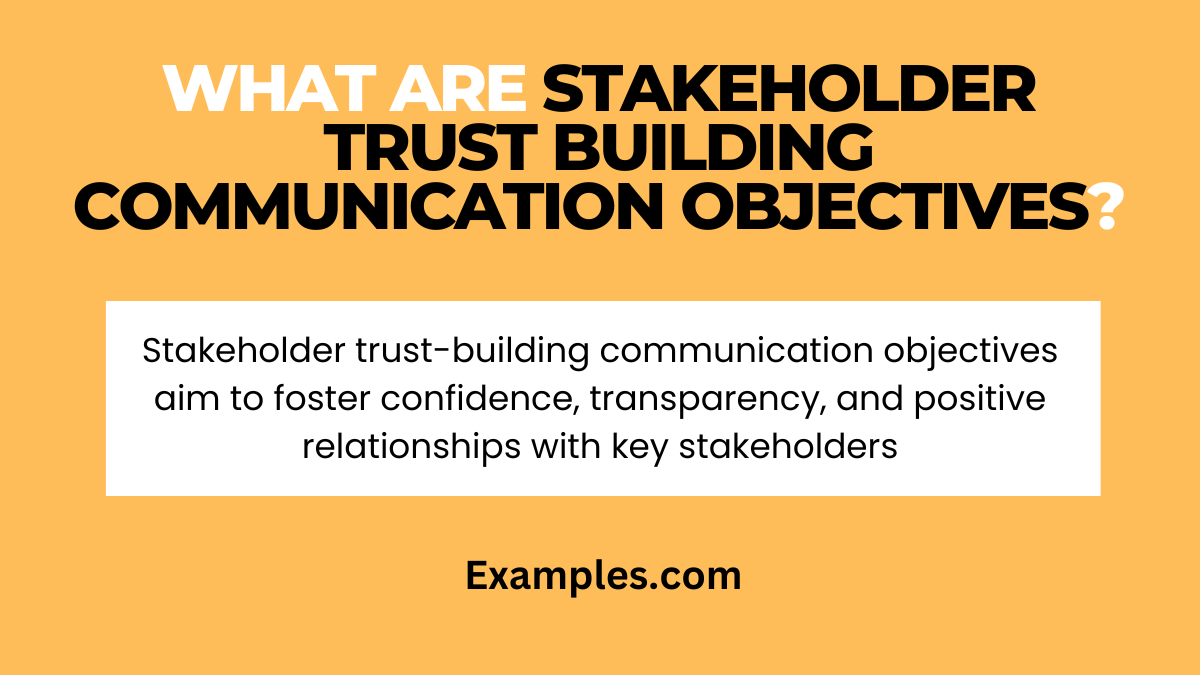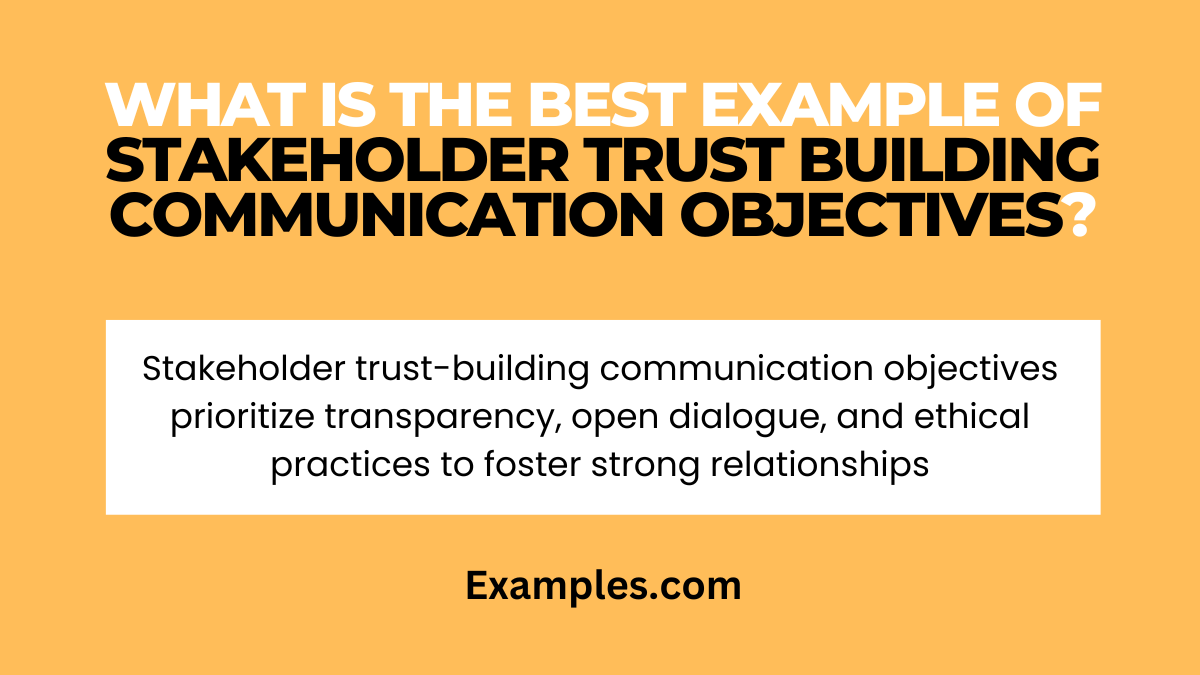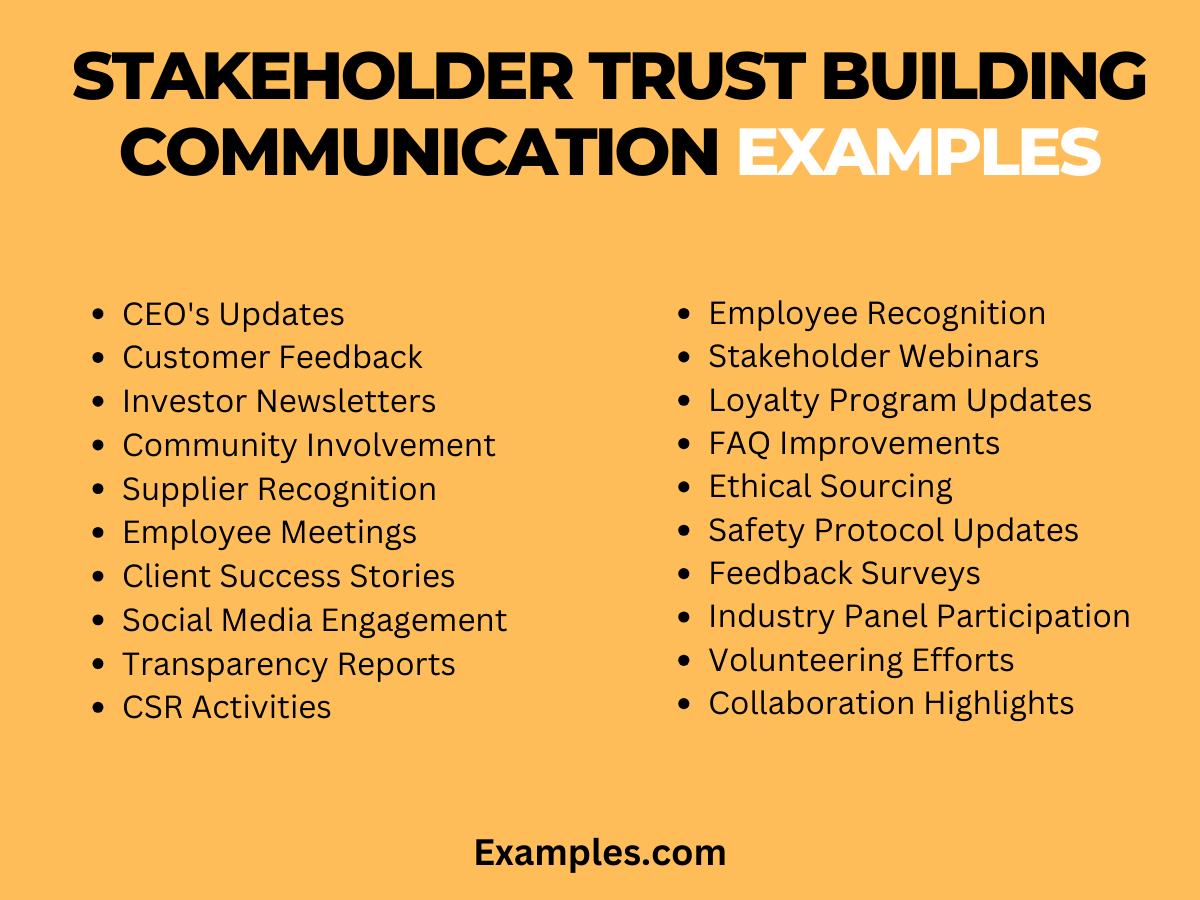Stakeholder Trust Building Communication Objectives
Stakeholder Trust Building Communication Objectives are crucial for any organization looking to establish and maintain trust with its key stakeholders, including customers, employees, investors, and partners. These objectives focus on transparent, consistent, and honest communication that fosters reliability and credibility. Implementing Communication Objectives aimed at trust-building not only enhances stakeholder relations but also contributes significantly to the overall reputation and success of the organization.
What are Stakeholder Trust Building Communication Objectives?

Stakeholder Trust Building Communication Objectives involve strategies and actions designed to cultivate trust and confidence among an organization’s stakeholders. These objectives st Building Communication Objectives are achieved through open, transparent communication that addresses stakeholder concerns, provides clear information, and involves stakeholders in decision-making processes. Effective trust-building communication is proactive, responsive, and consistent, ensuring that stakeholders feel valued, informed, and respected.
What is the Best Example of Stakeholder Trust Building Communication Objectives?

A prime example of Stakeholder Trust Building Communication Objectives is a company’s approach to handling a product recall. In this scenario, the company proactively communicates with customers, suppliers, and investors about the recall, explaining the reasons, the steps being taken to address the issue, and the measures implemented to prevent future occurrences. This open and honest communication approach helps maintain stakeholder trust even in challenging situations.
20 Stakeholder Trust Building Communication Examples

- CEO’s Regular Updates to Employees: Sharing company updates in a monthly email.
Example: “This month’s update highlights our team’s achievements and upcoming goals.” - Customer Feedback Response: Acknowledging and addressing customer feedback promptly.
Example: “Thank you for your feedback; we’re implementing changes based on your suggestions.” - Investor Newsletters: Quarterly newsletters updating investors on company progress.
Example: “Our quarterly newsletter details recent milestones and future projections.” - Community Involvement Announcements: Publicizing involvement in local community events.
Example: “We’re proud to support the upcoming community clean-up initiative.” - Supplier Partnership Acknowledgment: Recognizing the contributions of key suppliers.
Example: “Our success is partly thanks to our dedicated suppliers.” - Employee Town Hall Meetings: Hosting regular meetings to discuss company matters.
Example: “Join us for the town hall meeting to discuss new initiatives.” - Client Case Studies: Sharing success stories of client collaborations.
Example: “Our latest case study showcases a successful client partnership.” - Social Media Engagement with Followers: Actively responding to comments and messages.
Example: “We love hearing your thoughts! Keep the comments coming.” - Transparency Reports: Publishing reports on company operations and ethics.
Example: “Our annual transparency report is now available for review.” - CSR Activity Reports: Communicating corporate social responsibility activities.
Example: “Our CSR report highlights our commitment to sustainability.” - Employee Recognition Posts: Celebrating employee achievements on social media.
Example: “Congratulations to our employee of the month, John Doe!” - Webinar Invitations for Stakeholders: Inviting stakeholders to informational webinars.
Example: “Join our webinar to learn about industry trends and insights.” - Customer Loyalty Program Updates: Informing customers of loyalty program benefits.
Example: “Our loyalty program now offers even more rewards!” - FAQ Updates for Customer Queries: Regularly updating FAQs based on customer inquiries.
Example: “We’ve updated our FAQs to better address your questions.” - Ethical Sourcing Statements: Communicating about ethically sourced materials.
Example: “We are committed to using only ethically sourced materials.” - Health and Safety Protocol Updates: Informing about updated workplace safety measures.
Example: “Your safety is our priority; here are the latest guidelines.” - Feedback Surveys for Service Improvement: Conducting surveys to improve services.
Example: “Help us improve by completing this short feedback survey.” - Participation in Industry Panels: Engaging in industry discussions and panels.
Example: “Our CEO will be part of the upcoming industry panel discussion.” - Volunteering and Philanthropy Efforts: Showcasing company volunteering activities.
Example: “Our team volunteered at the local food bank this weekend.” - Collaboration and Partnership Highlights: Highlighting successful collaborations with other businesses.
Example: “We’re excited to announce our new collaboration with XYZ Company.”
Each of these examples demonstrates effective ways to build and maintain trust with stakeholders, an essential component of any successful communication strategy.
Stakeholder Trust Building Communication in the Workplace
Effective Stakeholder Trust Building Communication in the workplace is vital for creating a positive organizational environment and ensuring long-term success.
- Transparent Communication with Employees: Regularly sharing company updates and decisions.
- Engaging with Employee Feedback: Actively listening and responding to employee concerns.
- Consistency in Messaging: Ensuring all communication is consistent and truthful.
- Ethical Business Practices: Demonstrating integrity in all business operations.
- Leadership Accessibility and Visibility: Leaders being approachable and visible to employees.
- Recognition and Appreciation: Acknowledging employee contributions and achievements.
- Fair Conflict Resolution: Addressing workplace conflicts impartially and openly.
- Training and Development Opportunities: Investing in employee growth and skill enhancement.
- Workplace Well-being Initiatives: Prioritizing employee health and well-being.
- Community Involvement and CSR: Involving employees in CSR activities and community engagement.
These practices help in building a trusting relationship between employers and employees, essential for a thriving workplace.
Goals to Improve Stakeholder Trust Building Communication Objectives
To enhance Stakeholder Trust Building Communication Objectives, certain goals must be set and pursued diligently.
- Fostering Openness and Honesty: Ensuring all communications are transparent and honest.
- Regular Stakeholder Engagement: Keeping stakeholders regularly informed and involved.
- Building Long-term Relationships: Focusing on sustained interactions with stakeholders.
- Addressing Stakeholder Concerns: Promptly and effectively responding to feedback.
- Maintaining Consistency: Being consistent in actions and communications.
- Demonstrating Reliability and Dependability: Proving to be a reliable partner or provider.
- Cultivating a Positive Reputation: Working towards a positive public image.
- Promoting Mutual Understanding: Ensuring stakeholders understand the company’s values and objectives.
Achieving these goals significantly enhances trust between the organization and its stakeholders.
Elements of Stakeholder Trust Building Communication Objectives
Key Elements of Stakeholder Trust Building Communication Objectives include strategies and practices that strengthen the trust factor.
- Clarity and Accuracy: Providing clear and accurate information.
- Timeliness: Communicating in a timely manner, especially during critical situations.
- Empathy and Understanding: Showing understanding and empathy in communications.
- Feedback Mechanisms: Implementing effective channels for receiving and acting on feedback.
- Consistent Engagement: Regular interactions with stakeholders.
- Credibility and Authenticity: Ensuring all communications are credible and authentic.
- Adaptability and Flexibility: Being adaptable in communication strategies.
- Cultural Sensitivity: Being aware and respectful of cultural differences in communication.
Incorporating these elements is crucial for effective stakeholder trust building.
Importance of Stakeholder Trust Building Communication Objectives
The Importance of Stakeholder Trust Building Communication Objectives cannot be overstated, as they are fundamental for any organization’s success.
- Enhancing Company Reputation: A strong reputation built on trust attracts more business and opportunities.
- Improving Stakeholder Relationships: Positive relationships with stakeholders lead to mutual benefits.
- Facilitating Smooth Business Operations: Trust simplifies and smoothes various business processes.
- Increasing Employee Satisfaction and Retention: Employees are more satisfied and committed in a trustworthy environment.
- Boosting Customer Loyalty: Trustworthy communication increases customer loyalty and retention.
- Attracting Investors: Investors are more likely to invest in companies they trust.
- Mitigating Risks: Reduces the risks associated with misinformation and misunderstanding.
- Enhancing Market Position: A trusted company is often a preferred choice in the market.
Trust-building communication is a cornerstone for building a robust and resilient organization.
Successfully implementing Stakeholder Trust Building Communication strategies is vital for any organization’s long-term success. This guide has highlighted the importance of clear, consistent, and ethical communication in building and maintaining stakeholder trust. By focusing on transparency, empathy, and engagement, organizations can create a foundation of trust that benefits all parties involved, from employees and customers to investors and partners, ultimately leading to a stronger, more resilient, and trusted organization.



